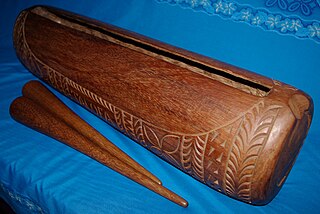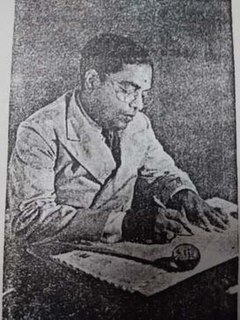
Samoa, officially the Independent State ofSamoa and, until 4 July 1997, known as Western Samoa, is a country consisting of two main islands, Savai'i and Upolu, and four smaller islands. The capital city is Apia. The Lapita people discovered and settled the Samoan Islands around 3,500 years ago. They developed a unique Samoan language and Samoan cultural identity.

Nataraja is a depiction of the Hindu god Shiva as the cosmic ecstatic dancer. His dance is called Tandavam or Nadanta, depending on the context of the dance. The pose and artwork is described in many Hindu texts such as the Anshumadbhed agama and Uttarakamika agama, the dance relief or idol featured in all major Hindu temples of Shaivism.

The Manu Siva Tau is a Samoan war dance, performed by the Samoan sporting teams before each match.

Savaiʻi is the largest and highest island in Samoa and the Samoan Islands chain. The island is the fifth largest in Polynesia, behind the two main islands of New Zealand and the Hawaiian Islands of Hawaii and Maui.

Traditional Samoan musical instruments included a fala, which is a rolled-up mat beaten with sticks. It is an idiophone which often accompanied choral singing. Another idiophone, a soundingboard, sometimes accompanied the solo recitation of poetry. A conch shell was blown for signaling. Amusement for small groups and individuals in private was afforded by a jaw harp, a raft panpipe, and a nose-blown flute.

The traditional music of Tuvalu consists of dances, including fatele, fakanau and fakaseasea. The influence of the Samoan missionaries sent to Tuvalu by the London Missionary Society from the 1860s resulted in the suppression of songs about the traditional religions or magic and many songs were lost. As the influence of the missionaries diminished in the 20th century the traditional dances were revived and the siva dance tradition from Samoa also became popular. The fatele, in its modern form, is performed at community events and to celebrate leaders and other prominent individuals.

The music of Tokelau occurs in the atolls of Atafu, Nukunonu, and Fakaofo. It is dominated by communal choral activity in harmony, with percussive accompaniment including log drums (pate), pokihi and apa. Nukunonu is notable for traditional song and dance.
The traditional culture of Samoa is a communal way of life based on Fa'a Samoa, the unique socio-political culture. In Samoan culture, most activities are done together. There are 3 main parts in the Samoan culture, that is faith, family and music. The traditional living quarters, or fale (houses), contain no walls and up to 20 people may sleep on the ground in the same fale. During the day, the fale is used for chatting and relaxing. One's family is viewed as an integral part of a person's life. The aiga or extended family lives and works together. Elders in the family are greatly respected and hold the highest status, and this may be seen at a traditional Sunday umu.

Samoans or Samoan people, are a Polynesian ethnic group native to the Samoan Islands, an archipelago in Polynesia, who speak the Samoan language. The group's home islands are politically and geographically divided between the Independent State of Samoa and American Samoa, an unincorporated territory of the United States of America. Though divided by government, the culture and language remain the same.

Polynesian culture is the culture of the indigenous peoples of Polynesia who share common traits in language, customs and society. Sequentially, the development of Polynesian culture can be divided into four different historical eras:
Palagi or papaalagi (plural) is a term in Samoan culture of uncertain meaning, sometimes used to describe foreigners. Tent and Geraghty (2001) comment that the origin of the Western Polynesian Papāalagi~Pālagi and the Fijian Vāvālagi~Pāpālagi remains a matter of speculation.
Siva Samoa is the Samoan term for a Samoan dance.

The Samoan national Australian rules football team and represents Samoa in the team sport of Australian rules football. The team is selected from the best Samoan born players, who are currently mostly players from the Samoa Australian Rules Football Association.
Sports in American Samoa are slightly different to sports in Samoa. The main difference is that Samoans in American Samoa are more likely to follow or play American sports such as American football, basketball, and baseball. Western Samoans are more likely to follow or play rugby union, rugby league, and netball. Sports such as mixed martial arts, boxing, professional wrestling, and volleyball are popular among most ethnic Samoans regardless of location.

The fire knife is a traditional Samoan cultural implement that is used in ceremonial dances. It was originally composed of a machete wrapped in towels on both ends with a portion of the blade exposed in the middle. Tribal performers of fire knife dancing dance while twirling the knife and doing other acrobatic stunts. The towels are set afire during the dances thus explaining the name.
Siumu is a village on the central south coast of Upolu island in Samoa. The population is 1,092. There is also a sub-village Siumu Uta which has a population of 206.
Mak Sa'moa is an informal Rotuman dance form derived from Samoan movement styles, including the style of hand movements between man and woman, and the shuffling/twisting of the feet in and out, as in the Siva Samoa.

Calambur Sivaramamurti, (1909–1983) was an Indian museologist, art historian and epigraphist who is primarily known for his work as curator in the Government Museum, Chennai. and Sanskrit scholar. His entire life has been devoted to the study and exposition of various aspects of Indian art. Apart from authoring several monographs, guide books on Indian art, he also wrote a seminal work on South Indian epigraphy.

A war dance is a dance involving mock combat, usually in reference to tribal warrior societies where such dances were performed as a ritual connected with endemic warfare. Martial arts in various cultures can be performed in dance-like settings for various reasons, such as for evoking ferocity in preparation for battle or showing off skill in a more stylized manner. It could also be for celebration of valor and conquest. Many such martial arts incorporate music, especially strong percussive rhythms.












